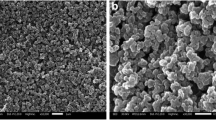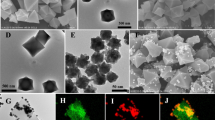Abstract
Self-supported Fe3N-Co2N nanoarray with high electric conductivity and large surface area was prepared for growth of MIPs and further constructing a sensitive and stable electrochemical sensor. For the evaluation of its performance, Fe3N-Co2N is used as sensing electrode material, and AMP is used as template molecule to construct the MIP electrochemical sensor. Under the optimized conditions, the developed MIPs electrochemical sensor detects AMP with a low detection limit of 3.65 × 10−10 mol L−1 and shows outstanding reproducibility and stability. When the MIPs electrochemical sensor was applied to detect AMP in milk samples via standard addition method, the recovery within 97.06–102.43% with RSD of 1.05–2.11% was obtained. The fabrication of MIPs electrochemical sensor is highly promising for sensitive and selective electrochemical measurement and food safety testing. This work can provide theoretical guidance for truly challenging problems.

Principle diagram of MIP-EC sensor for detecting AMP
Molecular imprinted polymers (MIPs) are widely performed for construction of electrochemical (EC) sensors especially for detecting small molecules in complex environment. However, the large-scale and robust preparation of MIPs in situ on sensor platform limits their practical applications. We fabricated a MIPs EC sensor based on Fe3N-Co2N in situ grown on carbon cloth (CC) as the substrate platform (Fe3N-Co2N/CC) combining with MIPs as the target recognition element for the label-free detection of AMP. Under the optimal conditions, the developed MIPs EC sensor can detect AMP with a low detection limit of 3.65 × 10−10 mol L−1. When the AMP in milk is detected by the proposed EC sensor, it shows ideal results. Therefore, the use of self-supported Fe3N-Co2N nanoarray as the platform for the fabrication of MIPs EC sensors is highly promising for sensitive and selective EC measurement and point-of-care testing.




Similar content being viewed by others
References
Huang Q, Zhao Z, Nie D, Jiang K, Guo W, Fan K, Zhang Z, Meng J, Wu Y, Han Z (2019) Molecularly imprinted poly(thionine)-based electrochemical sensing platform for fast and selective ultratrace determination of patulin. Anal Chem 91(6):4116–4123. https://doi.org/10.1021/acs.analchem.8b05791
Gui R, Jin H, Guo H, Wang Z (2018) Recent advances and future prospects in molecularly imprinted polymers-based electrochemical biosensors. Biosens Bioelectron 100:56–70. https://doi.org/10.1016/j.bios.2017.08.058
BelBruno JJ (2019) Molecularly imprinted polymers. Chem Rev 119(1):94–119. https://doi.org/10.1021/acs.chemrev.8b00171
Pei DN, Zhang AY, Pan XQ, Si Y, Yu HQ (2018) Electrochemical sensing of bisphenol A on facet-tailored TiO2 single crystals engineered by inorganic-framework molecular imprinting sites. Anal Chem 90(5):3165–3173. https://doi.org/10.1021/acs.analchem.7b04466
Zhang C, Zhao F, He Y, She Y, Hong S, Ma J, Wang M, Cao Z, Li T, Ei-Aty AMA, Ping J, Ying Y, Wang J (2019) A disposable electrochemical sensor based on electrospinning of molecularly imprinted nanohybrid films for highly sensitive determination of the organotin acaricide cyhexatin. Microchim Acta 186(8):504. https://doi.org/10.1007/s00604-019-3631-2
Ensafi AA, Nasr-Esfahani P, Rezaei B (2018) Metronidazole determination with an extremely sensitive and selective electrochemical sensor based on graphene nanoplatelets and molecularly imprinted polymers on graphene quantum dots. Sensors Actuators B Chem 270:192–199. https://doi.org/10.1016/j.snb.2018.05.024
Liu Z, Zhang Y, Feng J, Han Q, Wei Q (2019) Ni(OH)2 nanoarrays based molecularly imprinted polymer electrochemical sensor for sensitive detection of sulfapyridine. Sensors Actuators B Chem. https://doi.org/10.1016/j.snb.2019.02.079
Liu Z, Zhang Y, Li B, Ren X, Ma H, Wei Q (2020) Novel ratiometric electrochemical sensor for no-wash detection of fluorene-9-bisphenol based on combining CoN nanoarray with molecularly imprinted polymers. Analyst. https://doi.org/10.1039/D0AN00345J
Zhang Y, Chen X (2019) Nanotechnology and nanomaterial-based no-wash electrochemical biosensors: from design to application. Nanoscale 11(41):19105–19,118. https://doi.org/10.1039/C9NR05696C
Peng X, Pi C, Zhang X, Li S, Huo K, Chu PK (2019) Recent progress of transition metal nitrides for efficient electrocatalytic water splitting. Sustain Energy Fuels 3(2):366–381. https://doi.org/10.1039/C8SE00525G
Luo J, Zhao D, Yang M, Qu F (2018) Porous Ni3N nanosheet array as a catalyst for nonenzymatic amperometric determination of glucose. Microchim Acta 185(4):229. https://doi.org/10.1007/s00604-018-2764-z
Zhou D, Cao X, Wang Z, Hao S, Hou X, Qu F, Du G, Asiri AM, Zheng C, Sun X (2017) Fe3N-Co2N nanowires array: a non-noble-metal bifunctional catalyst electrode for high-performance glucose oxidation and H2O2 reduction toward non-enzymatic sensing applications. Chem Eur J 23(22):5214–5218. https://doi.org/10.1002/chem.201700594
Xie F, Cao X, Qu F, Asiri AM, Sun X (2018) Cobalt nitride nanowire array as an efficient electrochemical sensor for glucose and H2O2 detection. Sensors Actuators B Chem 255:1254–1261. https://doi.org/10.1016/j.snb.2017.08.098
Al-Momani IF (2004) Flow-injection spectrophotometric determination of amoxcillin, cephalexin, ampicillin, and cephradine in pharmaceutical formulations. Anal Lett 37(10):2099–2110. https://doi.org/10.1081/AL-200026683
Yu Z-g, Lai RY (2018) A reagentless and reusable electrochemical aptamer-based sensor for rapid detection of ampicillin in complex samples. Talanta 176:619–624. https://doi.org/10.1016/j.talanta.2017.08.057
Taghdisi SM, Danesh NM, Nameghi MA, Ramezani M, Alibolandi M, Abnous K (2019) An electrochemical sensing platform based on ladder-shaped DNA structure and label-free aptamer for ultrasensitive detection of ampicillin. Biosens Bioelectron 133:230–235. https://doi.org/10.1016/j.bios.2019.03.044
Song K-M, Jeong E, Jeon W, Cho M, Ban C (2012) Aptasensor for ampicillin using gold nanoparticle based dual fluorescence-colorimetric methods. Anal Bioanal Chem 402(6):2153–2161. https://doi.org/10.1007/s00216-011-5662-3
Luo W, Hansen EB, Ang CYW, Deck J, Freeman JP, Thompson HC (1997) Simultaneous determination of amoxicillin and ampicillin in bovine milk by HPLC with fluorescence detection. J Agric Food Chem 45(4):1264–1268. https://doi.org/10.1021/jf960739l
Rosati G, Ravarotto M, Scaramuzza M, De Toni A, Paccagnella A (2019) Silver nanoparticles inkjet-printed flexible biosensor for rapid label-free antibiotic detection in milk. Sensors Actuators B Chem 280:280–289. https://doi.org/10.1016/j.snb.2018.09.084
Raksawong P, Nurerk P, Chullasat K, Kanatharana P, Bunkoed O (2019) A polypyrrole doped with fluorescent CdTe quantum dots and incorporated into molecularly imprinted silica for fluorometric determination of ampicillin. Microchim Acta 186(6):338. https://doi.org/10.1007/s00604-019-3447-0
Wang J, Ma K, Yin H, Zhou Y, Ai S (2017) Aptamer based voltammetric determination of ampicillin using a single-stranded DNA binding protein and DNA functionalized gold nanoparticles. Microchim Acta 185(1):68. https://doi.org/10.1007/s00604-017-2566-8
Shayesteh OH, Ghavami R (2019) Two colorimetric ampicillin sensing schemes based on the interaction of aptamers with gold nanoparticles. Microchim Acta 186(7):485. https://doi.org/10.1007/s00604-019-3524-4
Luo J, Ma Q, Wei W, Zhu Y, Liu R, Liu X (2016) Synthesis of water-dispersible molecularly imprinted electroactive nanoparticles for the sensitive and selective paracetamol detection. ACS Appl Mater Interfaces 8(32):21028–21,038. https://doi.org/10.1021/acsami.6b05440
Motia S, Bouchikhi B, Llobet E, El Bari N (2020) Synthesis and characterization of a highly sensitive and selective electrochemical sensor based on molecularly imprinted polymer with gold nanoparticles modified screen-printed electrode for glycerol determination in wastewater. Talanta 216:120953. https://doi.org/10.1016/j.talanta.2020.120953
Kung CW, Lin CY, Lai YH, Vittal R, Ho KC (2011) Cobalt oxide acicular nanorods with high sensitivity for the non-enzymatic detection of glucose. Biosens Bioelectron 27(1):125–131. https://doi.org/10.1016/j.bios.2011.06.033
Guo C, Zhang X, Huo H, Xu C, Han X (2013) Co3O4 microspheres with free-standing nanofibers for high performance non-enzymatic glucose sensor. Analyst 138(22):6727–6731. https://doi.org/10.1039/C3AN01403G
Xie L, Asiri AM, Sun X (2017) Monolithically integrated copper phosphide nanowire: an efficient electrocatalyst for sensitive and selective nonenzymatic glucose detection. Sensors Actuators B Chem 244:11–16. https://doi.org/10.1016/j.snb.2016.12.093
Zhou N, Zhang J, Tian Y (2014) Aptamer-based spectrophotometric detection of kanamycin in milk. Anal Methods 6(5):1569–1574. https://doi.org/10.1039/C3AY41816B
Guliy OI, Zaitsev BD, Smirnov AV, Karavaeva OA, Borodina IA (2019) Sensor for ampicillin based on a microwave electrodynamic resonator. Biosens Bioelectron 130:95–102. https://doi.org/10.1016/j.bios.2019.01.030
Rašić Mišić I, Miletić G, Mitić S, Mitić M, Pecev-Marinković E (2013) A simple method for the ampicillin determination in pharmaceuticals and human urine. Chem Pharm Bull(Tokyo) 61(9):913–919. https://doi.org/10.1248/cpb.c13-00197
Rahman N, Khan S (2016) Circular dichroism spectroscopy: an efficient approach for the quantitation of ampicillin in presence of cloxacillin. Spectrochim Acta A Mol Biomol Spectrosc 160:26–33. https://doi.org/10.1016/j.saa.2016.02.009
Pérez MIB, Rodríguez LC, Cruces-Blanco C (2007) Analysis of different β-lactams antibiotics in pharmaceutical preparations using micellar electrokinetic capillary chromatography. J Pharm Biomed Anal 43(2):746–752. https://doi.org/10.1016/j.jpba.2006.07.035
Funding
This study is supported by the National Natural Science Foundation of China 21775053, the Natural Science Foundation of Shandong Province (No. 2019GSF111023, ZR2017MB027), and the National Key Scientific Instrument and Equipment Development Project of China (No. 21627809). Yong Zhang is sponsored by the China Scholarship Council (CSC), and Y. G. W. thanks the Program for Scientific Research Innovation Team in Colleges and Universities of Shandong Province.
Author information
Authors and Affiliations
Corresponding author
Ethics declarations
Conflict of interest
The authors declare no competing financial interest.
Additional information
Publisher’s note
Springer Nature remains neutral with regard to jurisdictional claims in published maps and institutional affiliations.
Electronic supplementary material
ESM 1
(DOCX 1.00 mb)
Rights and permissions
About this article
Cite this article
Liu, Z., Fan, T., Zhang, Y. et al. Electrochemical assay of ampicillin using Fe3N-Co2N nanoarray coated with molecularly imprinted polymer. Microchim Acta 187, 442 (2020). https://doi.org/10.1007/s00604-020-04432-2
Received:
Accepted:
Published:
DOI: https://doi.org/10.1007/s00604-020-04432-2




